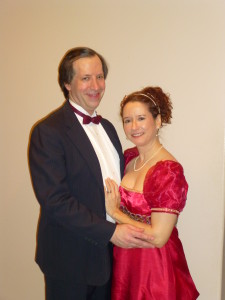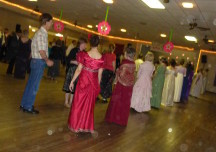So I went to a ball pt. 3

Balls and assemblies form a regular feature of Georgian and Regency era historical novels. Often heroes and heroines meet, flirt, fight, and even fall in love on the ballroom floor. But what was it really like to attend a ball? Recently I got to find out first hand.
In previous installments, I shared about the preparations leading up to the ball, finding a partner to dance with, mixer dances, meeting partners on the dancefloor. Now, on to the dances themselves and the all important flirting.
Dance Steps
The dances for the evening were all built from an array of standard steps. Most of them were simple maneuvers like: partners turn by the right hand and two couples all join right hands and turn once around. Complex movements like figure eights, ‘hays’ and dancing down the set were included as well. To help out the less experienced dancers, the caller would walk the group through the dance once or twice before the music began.
In many of the line-based dances, couples would ‘take hands four from the top’, that is they would form groups of two couples who would dance together for one repetition of the music. In simple dances, both couples would perform the same steps throughout the dance. More complicated dances might have the first and second couples executing completely different steps with one more complex than the other, as in Mr. Beveridge’s Maggot (featured in recent movie adaptations of both Austen’s Pride and Prejudice and Emma).
Mr. Beveridge’s Maggot
At the end of that repetition, the final steps ‘progress’ couples into new groups of four, first couples moving down the set to be first couple in the group one down from their previous position, and second couples moving up. In order for progression to work, couples at the top and bottom of the set would wait out a repetition of the music and not dance. This waiting out period offered a prime opportunity for couples to interact relatively privately on the dance floor.
In the span of a several minutes-long repetition, dancers might exchange pleasantries, flirtations, or even cross words. Whatever their conversation, though, they still had to pay attention to the music and other dancers so as not to miss their entry back into the set. At the next repetition they would rejoin the set, switching their role in the dance from first to second or second to first couple. While dancing Mr. Beveridge’s Maggot, my partner and I nervously watched the complicated first couple’s moves, hurriedly trying to refresh our memories on what we would have to do when we rejoined the set as first couples in a new group of four.
Not all dances offer these ‘time out’ periods. Circle dances and those done in sets of two or three couples require dancers to participate constantly, so little or no conversation might take place. Even so, a great deal of dance floor communication is possible without dialogue.
Eye Contact and other Communications
Eye contact plays a huge role in dance floor tête-à-têtes . Some partners engage in constant eye contact, holding their partners with their gaze in an almost physical grip. From a practical standpoint, the eye contact is a useful way to stave off dizziness in a dance that requires many rapid turns. At the same time though, such interchanges can become demanding and intimate, isolating the couple in a room full of people. I danced with a couple of different partners whose demand for eye contact ranged from friendly and flirtatious to downright intrusive.
Other partners offer little in the way of eye contact, even to the point of avoiding any direct gaze with their partner. An avoidant partner can communicate a variety of things from their own insecurity with the dance steps to disdain for their partner, all without uttering a single word. Dancing with someone who won’t even look at your face is difficult at best.
Subtle physical contact on the dance floor, usually restricted to taking hands or joining arms at the elbow for a turn, also speaks volumes when words are not possible. Hands might be taken, barely touching and only as long as necessary, or held reverently, lingering as long as possible in the connection. In moves like passing each other in the middle of the line or circling back to back, how close to you or how far away your partner remains communicates a strong message.
 The way partners dance together creates a conversation of facial expression and body language as eloquent as the finest speeches. A more experienced dancer can subtly and patiently assist a less certain dancer through complex steps with glances and subtle gestures, encouraging and praising with eyes and smiles. More than once I found myself gratefully on the receiving end of such coaching. Those partners were true gentlemen and made me feel very comfortable.
The way partners dance together creates a conversation of facial expression and body language as eloquent as the finest speeches. A more experienced dancer can subtly and patiently assist a less certain dancer through complex steps with glances and subtle gestures, encouraging and praising with eyes and smiles. More than once I found myself gratefully on the receiving end of such coaching. Those partners were true gentlemen and made me feel very comfortable.
Conversely, experienced dancers can declare disdain and even judgment on a struggling dancer even to the point of rough pushing or pulling that dancer into their correct position. Depending on the distraction created, the experience can be entirely humiliating, even physically painful. The aforementioned Bingley sisters were two such dancers. After my encounter with them I sat out several dances and made sure not to be a part of their set the rest of the evening. It was truly a horrible experience.
Partners who are equally anxious about getting the steps right, and good humored in their anxiety, can assist one another, laugh at missteps, and celebrate their victorious achievements as they progress through a series of complicated steps. The experience has the potential to be very revealing of character and offers a time for bonding over a shared challenge. A gentleman might even kiss a lady’s hand after surviving such a trial—a most romantic gesture indeed. I had one partner who did just that after we finally mastered a tricky hand clapping maneuver in a dance. I felt a little like a heroine in a novel.
When two proficient dancers partner, the flow of their coordinated movements creates a connection between them, bonding them in purpose and action. The communication and energy flowing between them can be visceral and compelling, poignant as the deepest conversation. Someday I hope to be able to dance well enough to experience what I saw our best dancers enjoying. No wonder young men often called upon their primary dance partner the next day.
Each Dance has a Unique Character
Each dance itself possesses its own character, some being staid and elegant and others playful and flirtatious. Mr. Beveridge’s Maggot is dignified and elegant, befitting a somber, formal occasion. Lord Byron’s Maggot—by the way, a maggot referred to a catchy tune, what we would today call an ‘ear worm’—suits its namesake. One set of steps involved the woman from the first couple approaching the man from the second couple with a flirtatious ‘come hither’ beckon to follow her. The second couple’s woman did the same with the first couple’s man. These suggestive moves could be made as token gestures or with sincere energy. Similarly, the playful ‘pat-a-cake’ moves later in the dance offered an ideal opportunity for more flirtation.
Lord Byron’s Maggot
The complicated, three couple dance, Hunt the Squiril (sic)requires the first couple to chase each other, weaving through the other dancers. My husband and Lady Congeniality had a wonderful time doing this dance and were amazingly entertaining to watch as they pursued one another.
Hunt the Squiril (sic)
So, even though a couple might not be able to converse outright much on the dance floor, be certain a great deal of communication and flirting can happen.
It is easy to see how in the period, where conversation was restricted to ‘polite’ topics and interactions between unmarried individuals were strictly chaperoned, the dance floor offered the one place where open expression was considered acceptable. There, individuals could be dramatic, funny and flirtatious without censure from society at large—provided of course that they did not take their self-expression too far. Therein lays the power and allure of the dance floor for hero and heroine, for there alone might they express what they could not say directly.
Beyond that, the dancing is just plain fun, even for someone with two left feet and little sense of rhythm (yours truly). Many areas have local groups that are always welcoming to new members

Comments
So I went to a ball pt. 3 — No Comments
HTML tags allowed in your comment: <a href="" title=""> <abbr title=""> <acronym title=""> <b> <blockquote cite=""> <cite> <code> <del datetime=""> <em> <i> <q cite=""> <s> <strike> <strong>